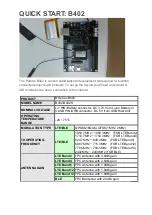
Curtis 1214-/15-/19-8 Manual
14
INSTALLATION CHECKOUT
Before operating the vehicle, carefully complete the following checkout proce-
dure. If you find a problem during the checkout, refer to the diagnostics and
troubleshooting section (Section 5) for further information.
The installation checkout can be conducted with or without the handheld
programmer. The checkout procedure is easier with a programmer. Otherwise,
observe the LED for diagnostic codes. (The codes are listed in Section 5.)
Put the vehicle up on blocks to get the drive wheels off
the ground before beginning these tests.
Do not stand, or allow anyone else to stand, directly in
front of or behind the vehicle during the checkout.
Make sure the keyswitch is off and the brake is applied
(brake switch open), the throttle is in neutral, and the
forward/reverse switches are open.
Wear safety glasses and use well-insulated tools.
1.
If a programmer is available, connect it to the programmer connector.
2.
Turn the keyswitch on. The programmer should “power up” with an
initial display, and the controller’s Status LED should begin steadily
blinking a single flash. If neither happens, check for continuity in the
keyswitch circuit and controller ground.
3.
If you are using a programmer, put it into the diagnostic mode by
pressing the
DIAGNOSTICS
key. The display should indicate “No Faults
Found.”
Close the brake/seat switch. To do this on a walkie, pull the tiller
down to the operating position. The LED should continue blinking a
single flash and the programmer should continue to indicate no faults.
If there is a problem, the LED will flash a diagnostic code and the
programmer will display a diagnostic message. If you are conducting the
checkout without a programmer, look up the LED diagnostic code in
Section 5 (Diagnostics and Troubleshooting).
When the problem has been corrected, it may be necessary to cycle
the brake/seat switch in order to clear the fault code.
2 — INSTALLATION & WIRING
☞
C A U T I O N
















































